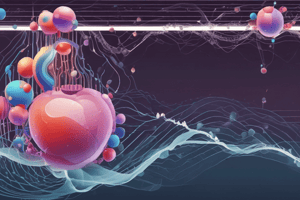Podcast
Questions and Answers
What is the primary function of lipoproteins in the human body?
What is the primary function of lipoproteins in the human body?
Which of the following lipoproteins carries triglycerides from the intestine to the liver?
Which of the following lipoproteins carries triglycerides from the intestine to the liver?
What is the role of lipoproteins in energy metabolism?
What is the role of lipoproteins in energy metabolism?
Which of the following is a precursor for hormone synthesis?
Which of the following is a precursor for hormone synthesis?
Signup and view all the answers
What is the characteristic of each type of lipoprotein?
What is the characteristic of each type of lipoprotein?
Signup and view all the answers
What is the role of lipoproteins in the transportation of lipids in the body?
What is the role of lipoproteins in the transportation of lipids in the body?
Signup and view all the answers
What is the main function of triglycerides in the body?
What is the main function of triglycerides in the body?
Signup and view all the answers
What is the primary characteristic of hydrophobic lipids?
What is the primary characteristic of hydrophobic lipids?
Signup and view all the answers
What is the function of apolipoproteins in lipids?
What is the function of apolipoproteins in lipids?
Signup and view all the answers
What is the source of endogenous lipids?
What is the source of endogenous lipids?
Signup and view all the answers
What is the role of phospholipids in lipids?
What is the role of phospholipids in lipids?
Signup and view all the answers
Why are lipids associated with proteins to form lipoproteins?
Why are lipids associated with proteins to form lipoproteins?
Signup and view all the answers
What is the function of cholesterol in the body?
What is the function of cholesterol in the body?
Signup and view all the answers
What is the characteristic of amphipathic compounds?
What is the characteristic of amphipathic compounds?
Signup and view all the answers
Study Notes
Introduction to Lipids
- Lipids are organic compounds containing hydrogen, carbon, and sometimes oxygen, forming the framework for living cell structure and function.
- Sources of lipids: exogenous (absorbed from diet) and endogenous (synthesized by hepatic cells and adipose tissue).
Types of Lipids
- Hydrophobic lipids (non-polar): triacylglycerol and cholesterol esters.
- Amphipathic lipids: phospholipids, fatty acids, and cholesterol.
- Lipids must be transported between tissues and organs through the blood, but are insoluble in water, requiring association with apolipoproteins to form water-miscible lipoproteins.
Lipoproteins
- Lipoproteins are multicomponent complexes of proteins and lipids, each with a characteristic molecular mass, size, composition, density, and physiological role.
- Lipoproteins transport insoluble lipids in blood plasma, delivering lipid forms (cholesterol and TAG) from one organ to another for utilization.
- Components of lipoproteins:
- Phospholipids, cholesterol, and proteins outside/ exterior.
- Cholesteryl esters and TAG inside/ interior.
Functions of Lipoproteins
- Lipoproteins serve as transport vehicles for exogenous and endogenous lipids.
- They provide substrates for energy metabolism (TAG), essential components for cell structure (PL, cholesterol), and precursors for hormones, bile acids, and bile salts (cholesterol).
- Lipoproteins carry lipid-soluble vitamins (KEDA).
Types of Lipoproteins
- Four major types of lipoproteins:
- Chylomicron (CM): carries TG from intestine to liver.
- Very low density lipoproteins (VLDL): carries TG from liver to other body cells.
- Low density lipoproteins (LDL): carries cholesterol to all body cells.
Studying That Suits You
Use AI to generate personalized quizzes and flashcards to suit your learning preferences.
Description
This quiz covers the introduction to lipids, their structure, and function in the context of advanced clinical biochemistry. It explores lipids, lipoproteins, and their disorders.




